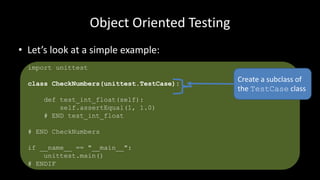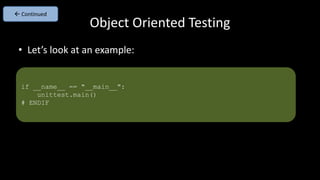Python: Object-Oriented Testing (Unit Testing)
- 1. Object Oriented Testing (Unit Testing) Damian Gordon
- 2. Object Oriented Testing • Unit Testing is concerned with testing small chunks of a program, for example, testing a single class or a single method. • Python has a library for unit testing called unittest. It provides several tools for creating and running unit tests.
- 3. Object Oriented Testing • One of the most important classes in unittest is called TestCase which provides a set of methods to compare values, set up tests and clean up after tests are finished. • To write unit tests, we create a subclass of TestCase and write individual methods to do the actual testing. Typically we start all of these methods with the name test.
- 4. Object Oriented Testing • Let’s look at a simple example:
- 5. Object Oriented Testing • Let’s look at a simple example: import unittest class CheckNumbers(unittest.TestCase): def test_int_float(self): self.assertEqual(1, 1.0) # END test_int_float # END CheckNumbers if __name__ == "__main__": unittest.main() # ENDIF
- 6. Object Oriented Testing • Let’s look at a simple example: import unittest class CheckNumbers(unittest.TestCase): def test_int_float(self): self.assertEqual(1, 1.0) # END test_int_float # END CheckNumbers if __name__ == "__main__": unittest.main() # ENDIF Create a subclass of the TestCase class
- 7. Object Oriented Testing • Let’s look at a simple example: import unittest class CheckNumbers(unittest.TestCase): def test_int_float(self): self.assertEqual(1, 1.0) # END test_int_float # END CheckNumbers if __name__ == "__main__": unittest.main() # ENDIF Create a subclass of the TestCase class This test checks if the integer and real value 1 are equal.
- 8. Object Oriented Testing • Let’s look at a simple example: import unittest class CheckNumbers(unittest.TestCase): def test_int_float(self): self.assertEqual(1, 1.0) # END test_int_float # END CheckNumbers if __name__ == "__main__": unittest.main() # ENDIF Make sure this is being run as a script Create a subclass of the TestCase class This test checks if the integer and real value 1 are equal.
- 9. Object Oriented Testing • And if we run this, we get:
- 10. Object Oriented Testing • And if we run this, we get: . ------------------------------------------------- Ran 1 test in 0.020s OK
- 11. Object Oriented Testing • And if we run this, we get: . ------------------------------------------------- Ran 1 test in 0.020s OK Dot means the test has passed
- 12. Object Oriented Testing • Let’s try another example:
- 13. Object Oriented Testing • Let’s try another example: import unittest class CheckNumbers(unittest.TestCase): def test_string_float(self): self.assertEqual(“1”, 1.0) # END test_string_float # END CheckNumbers if __name__ == "__main__": unittest.main() # ENDIF
- 14. Object Oriented Testing • Let’s try another example: import unittest class CheckNumbers(unittest.TestCase): def test_string_float(self): self.assertEqual(“1”, 1.0) # END test_string_float # END CheckNumbers if __name__ == "__main__": unittest.main() # ENDIF This test checks if the string and real value 1 are equal.
- 15. Object Oriented Testing • And if we run this, we get:
- 16. Object Oriented Testing • And if we run this, we get: F ========================================================= FAIL: test_string_float (__main__.CheckNumbers) This test checks if the string and real value 1 are equal. -------------------------------------------------------- Traceback (most recent call last): File "C:/Users/damian/AppData/Local/Programs/Python/Python35- 32/CheckNumbers-string-float.py", line 9, in test_string_float self.assertEqual("1", 1.0) AssertionError: '1' != 1.0 -------------------------------------------------------- Ran 1 test in 0.060s FAILED (failures=1)
- 17. Object Oriented Testing • And if we run this, we get: F ========================================================= FAIL: test_string_float (__main__.CheckNumbers) This test checks if the string and real value 1 are equal. -------------------------------------------------------- Traceback (most recent call last): File "C:/Users/damian/AppData/Local/Programs/Python/Python35- 32/CheckNumbers-string-float.py", line 9, in test_string_float self.assertEqual("1", 1.0) AssertionError: '1' != 1.0 -------------------------------------------------------- Ran 1 test in 0.060s FAILED (failures=1) “F” means the test has failed
- 18. Object Oriented Testing • Let’s combine the two tests together:
- 19. Object Oriented Testing • Let’s combine the two tests together: import unittest class CheckNumbers(unittest.TestCase): if __name__ == "__main__": unittest.main() # ENDIF def test_int_float(self): self.assertEqual(1, 1.0) # END test_int_float def test_string_float(self): self.assertEqual(“1”, 1.0) # END test_string_float
- 20. Object Oriented Testing • And if we run this, we get:
- 21. Object Oriented Testing • And if we run this, we get: .F ================================================================= FAIL: test_string_float (__main__.CheckNumbers) ---------------------------=------------------------------------- Traceback (most recent call last): File "C:UsersdamianAppDataLocalProgramsPythonPython35- 32CheckNumbers.py", line 10, in test_string_float self.assertEqual("1", 1.0) AssertionError: '1' != 1.0 ----------------------------------------------------------------- Ran 2 tests in 0.010s FAILED (failures=1)
- 22. Object Oriented Testing • And if we run this, we get: .F ================================================================= FAIL: test_string_float (__main__.CheckNumbers) ---------------------------=------------------------------------- Traceback (most recent call last): File "C:UsersdamianAppDataLocalProgramsPythonPython35- 32CheckNumbers.py", line 10, in test_string_float self.assertEqual("1", 1.0) AssertionError: '1' != 1.0 ----------------------------------------------------------------- Ran 2 tests in 0.010s FAILED (failures=1) “.F” means the first test passed and the second test has failed
- 24. Object Oriented Testing • A test case typically sets certain variables to known values, runs one or more methods or processes, and then show that correct expected results were returned by using TestCase assertion methods. • There are a few different assertion methods available to confirm that specific results have been achieved. We already saw assertEqual, which will cause a test failure if the two parameters do not pass an equality check. The inverse, assertNotEqual, will fail if the two parameters do compare as equal.
- 25. Object Oriented Testing • The assertTrue and assertFalse methods each accept a single expression, and fail if the expression does not pass an IF test. These tests are not checking for the Boolean values True or False, but instead: – To pass the assertFalse method the test should return False, None, 0, or an empty list, dictionary, string, set, or tuple. – To pass the assertFalse method the test should return True, non-zero numbers, containers with values in.
- 26. Methods Description assertEqual assertNotEqual Accept two comparable objects and ensure the named equality holds. assertTrue assertFalse Accept a single expression, and fail if the expression does not pass an IF test. assertGreater assertGreaterEqual assertLess assertLessEqual Accept two comparable objects and ensure the named inequality holds. asssertIn assertNotIn Ensure an element is (or is not) an element in a container object. assertIsNone assertIsNotNone Ensure an element is (or is not) the exact value None (but not another false value). assertSameElements Ensure two container objects have the same elements, ignoring the order. assertSequenceEqualassertDictEqual assertSetEqual assertListEqual assertTupleEqual Ensure two containers have the same elements in the same order. If there's a failure, show a code diff comparing the two lists to see where they differ. The last four methods also test the type of the list. assertRaises Ensure that a specific function call raises a specific exception.
- 27. Object Oriented Testing • Let’s look at the assertRaises method in a bit more detail. • This method can be used to ensure a specific function call raises a specific exception. The test passes if the code inside the with statement raises the proper exception; otherwise, it fails.
- 28. Object Oriented Testing • Let’s look at an example:
- 29. Object Oriented Testing • Let’s look at an example: import unittest def MyAverage(seq): return sum(seq) / len(seq) # END average Continued
- 30. • Let’s look at an example: Object Oriented Testing class TestAverage(unittest.TestCase): def test_zero(self): self.assertRaises(ZeroDivisionError, MyAverage, []) # END test_zero def test_with_zero(self): with self.assertRaises(ZeroDivisionError): MyAverage([]) # END test_with_zero # END CLASS TestAverage Continued Continued
- 31. • Let’s look at an example: Object Oriented Testing class TestAverage(unittest.TestCase): def test_zero(self): self.assertRaises(ZeroDivisionError, MyAverage, []) # END test_zero def test_with_zero(self): with self.assertRaises(ZeroDivisionError): MyAverage([]) # END test_with_zero # END CLASS TestAverage Continued Continued We can test if a call to MyAverage gives an error is a blank list is passed in
- 32. • Let’s look at an example: Object Oriented Testing class TestAverage(unittest.TestCase): def test_zero(self): self.assertRaises(ZeroDivisionError, MyAverage, []) # END test_zero def test_with_zero(self): with self.assertRaises(ZeroDivisionError): MyAverage([]) # END test_with_zero # END CLASS TestAverage Continued Continued We can test if a call to MyAverage gives an error is a blank list is passed in The same test, but calling the method directly, which will return a divide-by-zero error, so we need to use the with statement to tidy up.
- 33. Object Oriented Testing • Let’s look at an example: if __name__ == "__main__": unittest.main() # ENDIF Continued
- 34. Object Oriented Testing • Now let’s look at a more detailed example. • Let’s look at a program, and it’s test program: Stats.py Stats-test.py class StatsList class TestValidInputs def mean def median def mode def test_mean def test_median def test_mode
- 35. Object Oriented Testing • Here’s stats.py: from collections import defaultdict class StatsList(list): def mean(self): return sum(self) / len(self) # END mean Continued
- 36. • Here’s stats.py: Object Oriented Testing Continued Continued def median(self): if len(self) % 2: return self[int(len(self) / 2)] else: idx = int(len(self) / 2) return (self[idx] + self[idx-1]) / 2 # ENDIF # END median
- 37. • Here’s stats.py: Object Oriented Testing Continued def mode(self): freqs = defaultdict(int) for item in self: freqs[item] += 1 mode_freq = max(freqs.values()) modes = [] for item, value in freqs.items(): if value == mode_freq: modes.append(item) # ENDIF # ENDFOR return modes # END mode
- 38. Object Oriented Testing • We are going to test this program by creating a new file with our testing code in it. • So we’ll import unittest, and use the TestCase class from it, to create a setUp method to do initialization for each test. • The setUp method accepts no arguments, and allows us to do arbitrary setup before each test is run.
- 39. Object Oriented Testing • Here’s stats-test.py: from stats import StatsList import unittest class TestValidInputs(unittest.TestCase): def setUp(self): self.stats = StatsList([1,2,2,3,3,4]) # END setUp Continued
- 40. Object Oriented Testing • Here’s stats-test.py: from stats import StatsList import unittest class TestValidInputs(unittest.TestCase): def setUp(self): self.stats = StatsList([1,2,2,3,3,4]) # END setUp Continued Import the program we’ve just created, and it’s main class.
- 41. Object Oriented Testing • Here’s stats-test.py: from stats import StatsList import unittest class TestValidInputs(unittest.TestCase): def setUp(self): self.stats = StatsList([1,2,2,3,3,4]) # END setUp Continued Import the program we’ve just created, and it’s main class. Import unittest.
- 42. Object Oriented Testing • Here’s stats-test.py: from stats import StatsList import unittest class TestValidInputs(unittest.TestCase): def setUp(self): self.stats = StatsList([1,2,2,3,3,4]) # END setUp Continued Import the program we’ve just created, and it’s main class. Import unittest. Create the setup method, to set up values to be tested.
- 43. • Here’s stats-test.py: Object Oriented Testing Continued Continued def test_mean(self): self.assertEqual(self.stats.mean(), 2.5) # END test_mean
- 44. • Here’s stats-test.py: Object Oriented Testing Continued Continued def test_median(self): self.assertEqual(self.stats.median(), 2.5) self.stats.append(4) self.assertEqual(self.stats.median(), 3) # END test_median
- 45. • Here’s stats-test.py: Object Oriented Testing Continued def test_mode(self): self.assertEqual(self.stats.mode(), [2,3]) self.stats.remove(2) self.assertEqual(self.stats.mode(), [3]) # END test_mode
- 46. Object Oriented Testing • And if we run this, we get:
- 47. Object Oriented Testing • And if we run this, we get: ... ---------------------------------------------------------- Ran 3 tests in 0.050s OK
- 48. Object Oriented Testing • And if we run this, we get: ... ---------------------------------------------------------- Ran 3 tests in 0.050s OK “…” means all three tests have passed
- 49. Object Oriented Testing • The setUp method is never explicitly called inside any of the three test_* methods, the test suite does the call. • Also note that test_median alters the list, by adding a “4” to it, yet when test_mode is called, the list has returned to the values specified in setUp. This shows that setUp is called individually before each test, to ensure the test class starts with a clean slate. Tests can be executed in any order, and the results of one test should not depend on any other tests.
- 50. Object Oriented Testing • TestCase also offers a no-argument tearDown method, which can be used for cleaning up after each and every test on the class has run. • This is useful, for example, if we are testing code that does file I/O, our tests may create new files as a side effect of testing; the tearDown method can remove these files and ensure the system is in the same state it was before the tests ran. • Test cases should never have side effects.
- 51. etc.






























![• Let’s look at an example:
Object Oriented Testing
class TestAverage(unittest.TestCase):
def test_zero(self):
self.assertRaises(ZeroDivisionError, MyAverage, [])
# END test_zero
def test_with_zero(self):
with self.assertRaises(ZeroDivisionError):
MyAverage([])
# END test_with_zero
# END CLASS TestAverage
Continued
Continued](https://image.slidesharecdn.com/34c-unittesting-161229164339/85/Python-Object-Oriented-Testing-Unit-Testing-30-320.jpg)
![• Let’s look at an example:
Object Oriented Testing
class TestAverage(unittest.TestCase):
def test_zero(self):
self.assertRaises(ZeroDivisionError, MyAverage, [])
# END test_zero
def test_with_zero(self):
with self.assertRaises(ZeroDivisionError):
MyAverage([])
# END test_with_zero
# END CLASS TestAverage
Continued
Continued
We can test if a call to
MyAverage gives an error is
a blank list is passed in](https://image.slidesharecdn.com/34c-unittesting-161229164339/85/Python-Object-Oriented-Testing-Unit-Testing-31-320.jpg)
![• Let’s look at an example:
Object Oriented Testing
class TestAverage(unittest.TestCase):
def test_zero(self):
self.assertRaises(ZeroDivisionError, MyAverage, [])
# END test_zero
def test_with_zero(self):
with self.assertRaises(ZeroDivisionError):
MyAverage([])
# END test_with_zero
# END CLASS TestAverage
Continued
Continued
We can test if a call to
MyAverage gives an error is
a blank list is passed in
The same test, but calling the
method directly, which will
return a divide-by-zero error,
so we need to use the with
statement to tidy up.](https://image.slidesharecdn.com/34c-unittesting-161229164339/85/Python-Object-Oriented-Testing-Unit-Testing-32-320.jpg)



![• Here’s stats.py:
Object Oriented Testing
Continued
Continued
def median(self):
if len(self) % 2:
return self[int(len(self) / 2)]
else:
idx = int(len(self) / 2)
return (self[idx] + self[idx-1]) / 2
# ENDIF
# END median](https://image.slidesharecdn.com/34c-unittesting-161229164339/85/Python-Object-Oriented-Testing-Unit-Testing-36-320.jpg)
![• Here’s stats.py:
Object Oriented Testing
Continued
def mode(self):
freqs = defaultdict(int)
for item in self:
freqs[item] += 1
mode_freq = max(freqs.values())
modes = []
for item, value in freqs.items():
if value == mode_freq:
modes.append(item)
# ENDIF
# ENDFOR
return modes
# END mode](https://image.slidesharecdn.com/34c-unittesting-161229164339/85/Python-Object-Oriented-Testing-Unit-Testing-37-320.jpg)

![Object Oriented Testing
• Here’s stats-test.py:
from stats import StatsList
import unittest
class TestValidInputs(unittest.TestCase):
def setUp(self):
self.stats = StatsList([1,2,2,3,3,4])
# END setUp
Continued ](https://image.slidesharecdn.com/34c-unittesting-161229164339/85/Python-Object-Oriented-Testing-Unit-Testing-39-320.jpg)
![Object Oriented Testing
• Here’s stats-test.py:
from stats import StatsList
import unittest
class TestValidInputs(unittest.TestCase):
def setUp(self):
self.stats = StatsList([1,2,2,3,3,4])
# END setUp
Continued
Import the program we’ve just
created, and it’s main class.](https://image.slidesharecdn.com/34c-unittesting-161229164339/85/Python-Object-Oriented-Testing-Unit-Testing-40-320.jpg)
![Object Oriented Testing
• Here’s stats-test.py:
from stats import StatsList
import unittest
class TestValidInputs(unittest.TestCase):
def setUp(self):
self.stats = StatsList([1,2,2,3,3,4])
# END setUp
Continued
Import the program we’ve just
created, and it’s main class.
Import unittest.](https://image.slidesharecdn.com/34c-unittesting-161229164339/85/Python-Object-Oriented-Testing-Unit-Testing-41-320.jpg)
![Object Oriented Testing
• Here’s stats-test.py:
from stats import StatsList
import unittest
class TestValidInputs(unittest.TestCase):
def setUp(self):
self.stats = StatsList([1,2,2,3,3,4])
# END setUp
Continued
Import the program we’ve just
created, and it’s main class.
Import unittest.
Create the setup method, to
set up values to be tested.](https://image.slidesharecdn.com/34c-unittesting-161229164339/85/Python-Object-Oriented-Testing-Unit-Testing-42-320.jpg)


![• Here’s stats-test.py:
Object Oriented Testing
Continued
def test_mode(self):
self.assertEqual(self.stats.mode(), [2,3])
self.stats.remove(2)
self.assertEqual(self.stats.mode(), [3])
# END test_mode](https://image.slidesharecdn.com/34c-unittesting-161229164339/85/Python-Object-Oriented-Testing-Unit-Testing-45-320.jpg)





